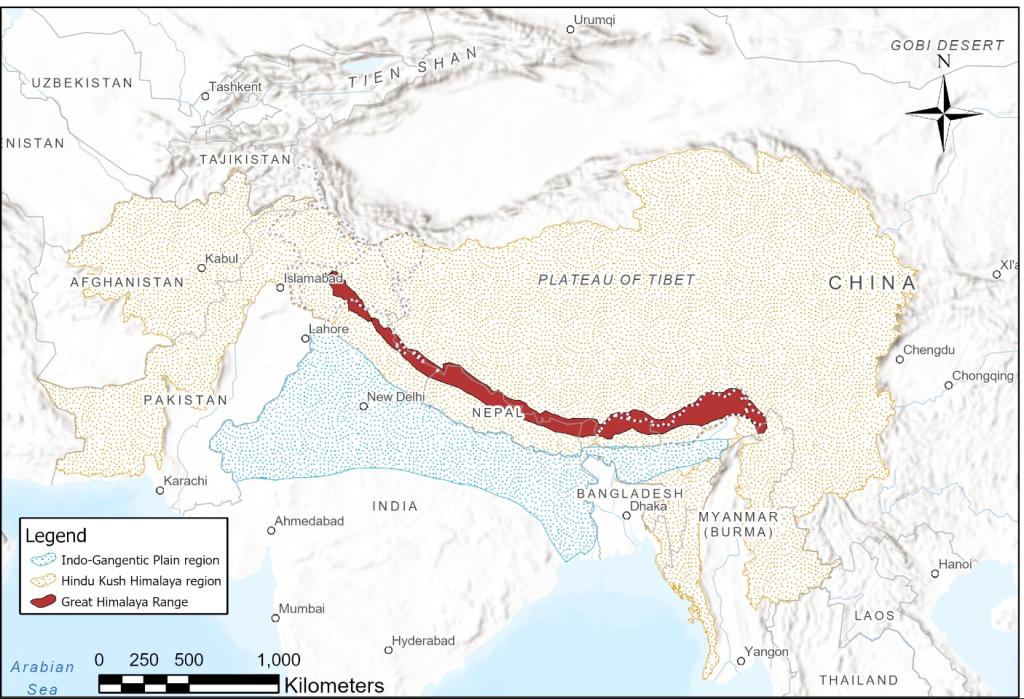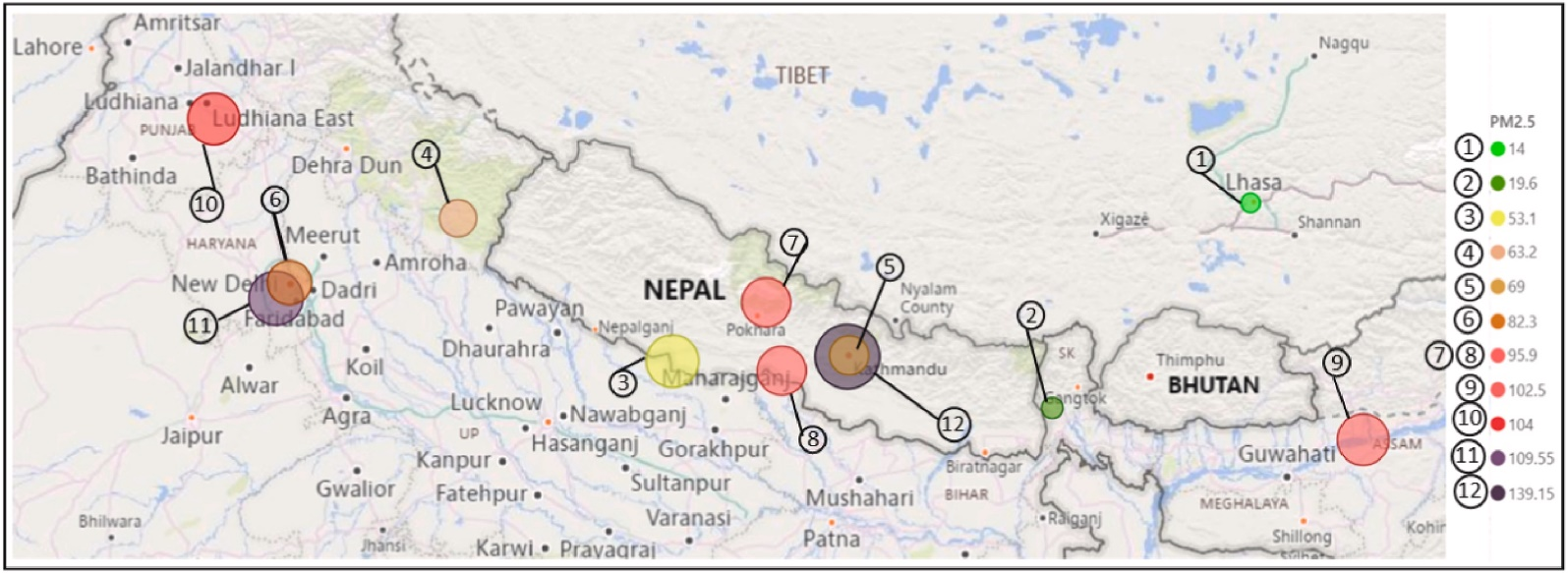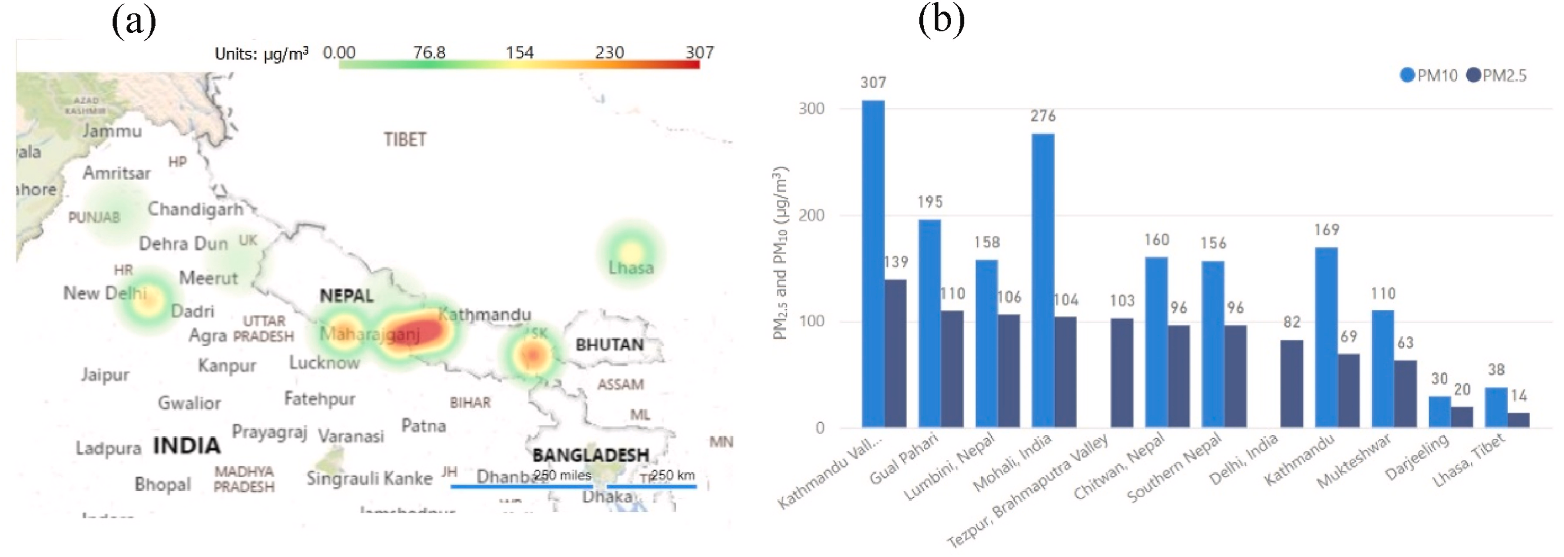时间:2022-12-15 点击量:

Journal: Atmospheric Environment
Impact Factor: 5.7
Title: A review of particulate pollution over Himalaya region: Characteristics and salient factors contributing ambient PM pollution
喜马拉雅地区颗粒物污染综述:影响环境PM污染的特征和显著因素
Author List: Muhammad Azher Hassan, Tariq Mehmood (corresponding), Junjie Liu, Xiaosan Luo, Xinghua Li, Mohsin Tanveer, Muhammad Faheem, Awais Shakoor, Afzal Ahmed Dar, Muhammad Abid
Highlights:
· Characteristics of PM pollution in the Himalayas region are discussed.
· As a distant source, CRB in IGP contributes substantially to PM pollution in the Himalayas.
· PM pollution at high-altitude locations in the Himalayas is increasing.
· The unique topography and local weather dynamics intensify pollution in the Himalayas.
· Increasing black carbon in the Himalayas jeopardizes the monsoon and hydrological cycle.
讨论了喜马拉雅地区PM污染的特征。
作为一个长久的来源,IGP中的CRB对喜马拉雅地区的PM污染有很大的贡献。
喜马拉雅山脉高海拔地区的PM污染正在增加。
独特的地形和当地天气动态加剧了喜马拉雅地区的污染。
喜马拉雅地区黑碳的增加危及季风和水文循环。
Introduction:
The Himalayan belt of the highest mountainous regions and foothills runs along the northern edge of the Indian and Pakistani plateau. The South Asian zone has witnessed considerable economic development; however, it has been considered one of the most toxic and problematic air pollution “hotspots” globally. Swift industrialization and rapid urbanization have enhanced air pollution in IGP. For instance, its estimated fossil-fuel black carbon (BC) emission increased from ∼1.3 Tg/year to ∼1.6 Tg/year between 1950 and 1990, and an alarming increase in airborne particulates was witnessed, especially in cities. In most environmental scientific studies on Asian cities, emphasis has been noticed on large cities of China and the IGP (Indo-Gangetic Plain). Extreme PM2.5 pollution has domestic and transboundary repercussions, resulting in an average life expectancy (LE) rate loss for Bangladesh, India, and Pakistan of more than 2.8 years in 2018, and it is responsible for more than a third of all deaths caused by poor air quality worldwide.
喜马拉雅山脉的最高山区和山麓地带沿着印度和巴基斯坦高原的北部边缘延伸。南亚地区经济发展迅速;然而,它被认为是全球最具毒性和问题的空气污染“热点”之一。快速的工业化和城市化加剧了IGP的空气污染。例如,1950年至1990年间,其化石燃料黑碳(BC)排放量大概从∼1.3 Tg/年至∼1.6 Tg/年,空气中颗粒物的增加令人震惊,尤其是在城市。在大多数关于亚洲城市的环境科学研究中,重点关注了中国和IGP(印度-恒河平原)的大城市。极端PM2.5污染对国内和跨境造成影响,导致孟加拉国、印度和巴基斯坦2018年的平均预期寿命(LE)率损失超过2.8年,且全球三分之一以上的死亡是由空气质量不佳造成的。
However, studies on the region's air quality are scarce. In IGP, studies of PM2.5 and PM10 have focused on urban areas. Very few high-altitude station studies in IGP have been recorded. Given the scarcity of studies (the majority of which are of short duration and focus on a single pollutant and satellite-based observation), unique topography, meteorological characteristics, monsoon dynamics, temperature inversion, and mixing of pollution emission from local and distant sources, it is difficult to understand the general pollution trend in the Himalaya. Nonetheless, past studies indicate that local biomass burning, long-distance transport, especially from the IGP, dust storms, and tourist activities are the primary drivers to rising PM pollution in the Himalayas region. Emissions from these sources develop exponentially and encompass severe pollution episodes because of the IGP's complicated hilly terrain, cloud condensation nucleation process, atmospheric brown clouds (haze), dust storm, and transport of PM from crop residue burning (especially during the post-monsoon season).
然而,对该地区空气质量的研究很少。在IGP,PM2.5和PM10的研究主要集中在城市地区。IGP中很少有高空站研究记录。鉴于缺乏研究(大多数研究持续时间短,侧重于单一污染物和基于卫星的观测)、独特的地形、气象特征、季风动力学、逆温以及本地和远距离污染排放的混合,很难理解喜马拉雅地区的总体污染趋势。尽管如此,过去的研究表明,当地生物质燃烧、长途运输,特别是来自IGP的运输、沙尘暴和旅游活动是喜马拉雅地区PM污染上升的主要驱动因素。由于IGP复杂的丘陵地形、云凝结成核过程、大气棕色云(雾霾)、沙尘暴以及农作物残渣燃烧产生的PM运输(特别是在后季风季节),这些来源的排放呈指数级增长,并包括严重的污染事件。
In light of this, the current work outlines the sources, factors, and variables that contribute to the Himalayan region's rising pollution levels and sheds light on significant areas of recent research. The present study examines in depth the consequences of the monsoon, the dynamics of pollution in IGP, and the movement of PM from IGP to the Himalayan region. This review aims to highlight research gaps and limitations in the existing literature for a better understanding of the current PM pollution in the Himalayas and surrounding sites, which is essential for understanding climate change and health consequences in this region, and to provide significant theoretical and practical implications for assessing particulate pollution in the Himalayas region.
鉴于此,当前工作概述了导致喜马拉雅地区污染水平上升的来源、因素和变量,并揭示了近期研究的重要领域。本研究深入研究了季风的后果、IGP中的污染动态以及PM从IGP向喜马拉雅地区的移动。本综述旨在突出现有文献中的研究差距和局限性,以更好地了解喜马拉雅山及其周边地区当前的PM污染,这对于了解该地区的气候变化和健康后果至关重要,并为评估喜马拉雅地区的颗粒物污染提供重要的理论和实践意义。

Fig. 1. Himalaya range with reference to Hindu Kush Himalaya (HKH) region and IGP region.
Literature Results:
Very few studies have investigated PM distribution in the entire Himalayas and Nepal specifically, and those have been confined to locations at considerable altitudes. Therefore, wind currents on the valley floor might carry pollution from the valley to the mountain peaks. No previous campaigns have been completed to explore the range of PM sizes in ridge-valley valleys and mid-altitude ridge-valley regions. Many significant cities and rural areas surrounding the HKH and IGP lack PM data monitoring. The information gaps are a direct result of a variety of problems. While Himalaya is exceptionally rugged, its varied topography and atmospheric fluctuations require a denser network of stations. Furthermore, the current usage of many instruments or methods at different locations necessitates the immediate creation of a single database through standardized measurements.
很少有研究专门调研整个喜马拉雅地区和尼泊尔的PM分布,这些研究仅限于相当高的海拔地区。因此,谷底的气流可能将污染从山谷带到山峰。此前尚未完成任何活动,以探索脊谷和中海拔脊谷地区的PM大小范围。HKH和IGP周围的许多重要城市和农村地区缺乏PM数据监测。信息差距是各种问题的直接结果。虽然喜马拉雅地区异常崎岖,但其多变的地形和大气波动需要更密集的台站网络。此外,目前在不同地点使用许多仪器或方法,需要通过标准化手段快速创建一个数据库。

Fig. 2. PM2.5 concentration (μg/m³) in Himalayas and adjacent regions.

Fig. 3. a) PM10 concentration heatmap b) City-wise PM2.5 and PM10 in Himalayas and adjacent regions.
Factor contributing to PM pollution in Himalaya region:
Increase in primary emissions along with unfavorable meteorological conditions (low temperature and poor dispersion) during winter could enhance the process of nucleation, condensation, agglomeration, and aging, leading to higher levels of carbonaceous aerosols in the study area. Below points are discussed in review paper with details include:
冬季初级排放量的增加以及不利的气象条件(低温和分散性差)可能会加剧成核、凝结、凝聚和老化的过程,导致研究区域的碳质气溶胶水平升高。综述文献中讨论了以下几点,详细内容包括:
· Monsoon impact
· Carbonaceous species
· PM-bound water-soluble inorganic ionic species
· PAHs and Biogenic sources
· Topography of Region
· Influences of emissions: anthropogenic versus biomass burning sources
· Transport from IGB to Himalaya
· Influences of meteorology and dynamics
· Cloud condensation nuclei
· Atmospheric Brown clouds (haze)
· Dust event
季风影响
碳质种类
PM结合的水溶性无机离子物质
多环芳烃和生物源
区域地形
排放的影响:人为与生物质燃烧源
从IGB到喜马拉雅的运输
气象和动力学的影响
云凝结核
大气棕色云(霾)
粉尘事件
Conclusion and future studies:
The spatial-temporal change of PM in the Himalayas region has its specific features, and the meteorological factors are essential factors that affect PM concentration. The topography, biomass burning, airmass trajectories, and meteorological factors strongly correlate with the PM concentration variation and the resultant deterioration of air quality in this region. These factors are the leading cause of both PM concentrations in the Himalayas region, exceeding the WHO standard for annual and 24 h (mostly during post-monsoon days). For future studies, several improvements and extensions are feasible, i.e., a more dependable automated weather station (AWS) should be installed for further research of the interplay between meteorological and pollution concentration characteristics. Continuous air pollution measurements would enable annual and seasonal variation studies all year round.
喜马拉雅地区PM的时空变化有其特殊性,气象因素是影响PM浓度的重要因素。地形、生物质燃烧、气团轨迹和气象因素与该地区PM浓度变化和由此导致的空气质量恶化密切相关。这些因素是喜马拉雅地区PM浓度超过了世界卫生组织的年度和24小时标准(大多在季风后)的主要原因。对于未来的研究,一些改进和扩展是可行的,即应安装更可靠的自动气象站(AWS),以进一步研究气象和污染浓度特征之间的相互作用。持续的空气污染测量将使全年和季节变化研究成为可能。
The air quality after the monsoon period of IGP is much more susceptible to meteorological and the amount of residue consumed in NW India than to the timing of residue burning changes. Therefore, it is essential to study further and begin rapid efforts to offer farmers inexpensive and sustainable alternative solutions to residue consumption to accelerate its effective ban, which is critical in reducing the intensity of the IGP air pollution episodes following the monsoon. Moreover, the people living in those urban areas inhale an extremely bad atmosphere, particularly in the non-rainy season. Thus, the current scenario calls on policymakers to take preventive action in good time to control such a harsher pollution scenario, especially in winter. An integrative approach based on collaboration among companies, government, and academia can improve PM10 and PM2.5 pollution monitoring, management, and mitigation in the Himalayas mountainous region.
IGP季风期后的空气质量更容易受到气象和印度西北部消耗的残留物数量的影响,而不是残留物燃烧变化的时间。因此,有必要进一步研究并开始迅速努力,为农民提供廉价和可持续的残留物消费替代解决方案,以加速其有效限制,这对于降低季风后IGP空气污染事件的强度至关重要。此外,生活在这些城市地区的人们吸入了极其恶劣的空气,特别是在非雨季。因此,当前的情景要求决策者及时采取预防措施,以控制如此严重的污染情景,尤其是在冬季。基于公司、政府和学术界合作的综合方法可以改善喜马拉雅山区PM10和PM2.5污染的监测、管理和缓解。
Overall, findings based on ground data indicate that annual mean PM2.5 and PM10 concentrations are significantly higher than health standards in many areas of IGP; for example, in Dhaka, PM2.5 and PM10concentrations are approximately 1.2–1.75 times higher than the standards across all monitoring locations; as a result, people living in urban areas are inhaling extremely unhealthy air. In Dhaka, where heart disease is thought to be on the rise, the negative effects of such poor air quality have already been noticed with a 12% increase in cardiovascular emergency room visits.
总体而言,基于地面数据的调查结果表明,在IGP的许多地区,PM2.5和PM10的年平均浓度显著高于健康标准;例如,在达卡,PM2.5和PM10浓度约为所有监测地点标准的1.2–1.75倍;因此,生活在城市地区的人们正在吸入极不健康的空气。在达卡,心脏病的发病率正在上升,人们已经注意到这种空气质量差的负面影响,心血管急诊室就诊人数增加了12%。
DOI: https://doi.org/10.1016/j.atmosenv.2022.119472
编辑人:Muhammad Azher Hassan
第一审核人:田媛
第二审核人:刘俊杰
第三审核人:何明桐
